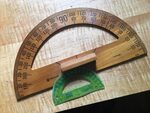We may receive a commission when you use our affiliate links. However, this does not impact our recommendations.
 Back when I was a young woodworker (shortly after the exit of the dinosaurs) I had a general acceptance of the reality that the planks of wood I purchased came from trees. I knew that they came in different colors, sizes and appearance, but the concept of how they ended up that way hadn’t really caused me much consideration. My education did advance, but I still hadn’t come face-to-face with the process of cutting wood until my co-worker Steve Shanesy became the recipient of a felled walnut tree in his neighborhood. That started me on an understanding that included a personal sawmill, a Wood-Mizer in fact. I learned about moving a full log and what that really meant. Then there was taking the empirical concept of cutting wood in simple slabs, plain-sawing, quarter-sawing, and the numerous factors that needed to be considered (splits, twists, limbs and much more) that also impacted the cutting process.
Back when I was a young woodworker (shortly after the exit of the dinosaurs) I had a general acceptance of the reality that the planks of wood I purchased came from trees. I knew that they came in different colors, sizes and appearance, but the concept of how they ended up that way hadn’t really caused me much consideration. My education did advance, but I still hadn’t come face-to-face with the process of cutting wood until my co-worker Steve Shanesy became the recipient of a felled walnut tree in his neighborhood. That started me on an understanding that included a personal sawmill, a Wood-Mizer in fact. I learned about moving a full log and what that really meant. Then there was taking the empirical concept of cutting wood in simple slabs, plain-sawing, quarter-sawing, and the numerous factors that needed to be considered (splits, twists, limbs and much more) that also impacted the cutting process.
The process itself was exhilarating! Watching a blade slice through a log with so little effort to create what would become furniture was eye-opening. Realizing that I could control the size and essentially the appearance of the wood coming off the log to best suit my needs was empowering. No more flipping through boards at the store trying to find the one that would be good enough! How can I share this feeling with you? How about a video. More accurately a series of videos, done in conjunction with Wood-Mizer, and the process of Milling Your Own Lumber. Starting Wednesday, September 19th we’ll post the first free video in the seven-part series on just that. We’ll cover the “why” and benefits of the process, as well as the general use of sawmills themselves and take you through the decision-making process in sawing lumber in multiple ways. We’ll also talk about the drying and stacking process after the wood is off the sawmill to make sure your wood is straight and plentiful. And because we know milling can be much more than a personal endeavor, we discuss the business side of using a sawmill as well.
Should you be one of the impatient, or if you’d just like to download the series, we’ve also made it available on shopwoodworking.com. We hope you’ll join us on this trip of discovery and education, and ultimately recognize the benefit of gaining control of how your lumber comes into your shop.
Here are some supplies and tools we find essential in our everyday work around the shop. We may receive a commission from sales referred by our links; however, we have carefully selected these products for their usefulness and quality.








